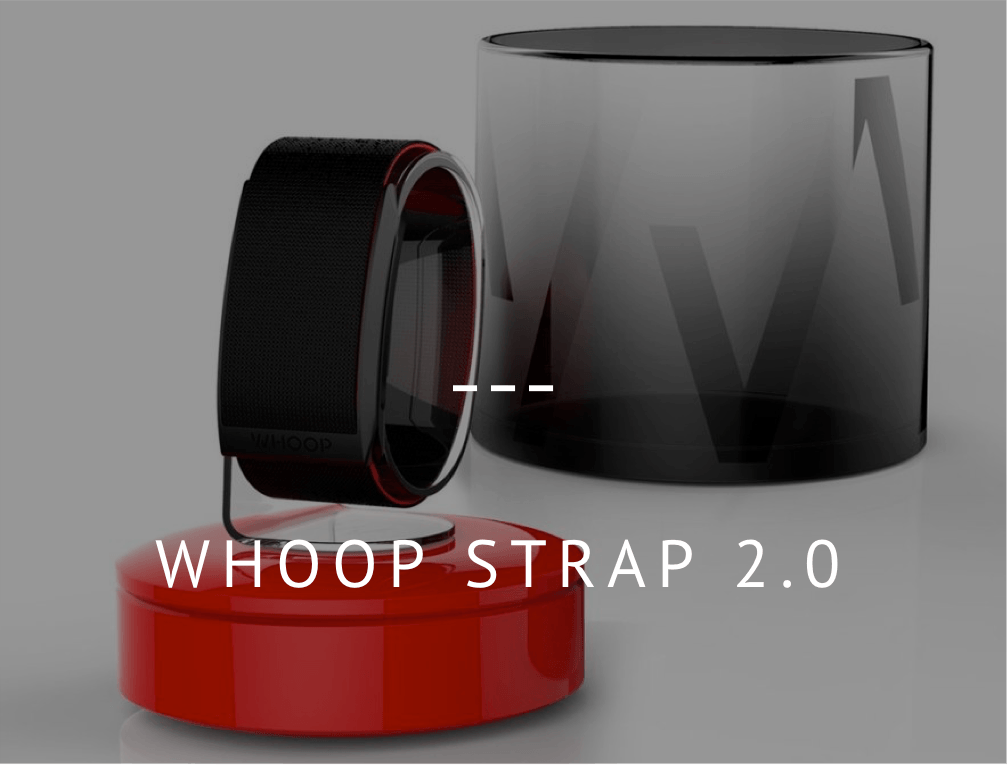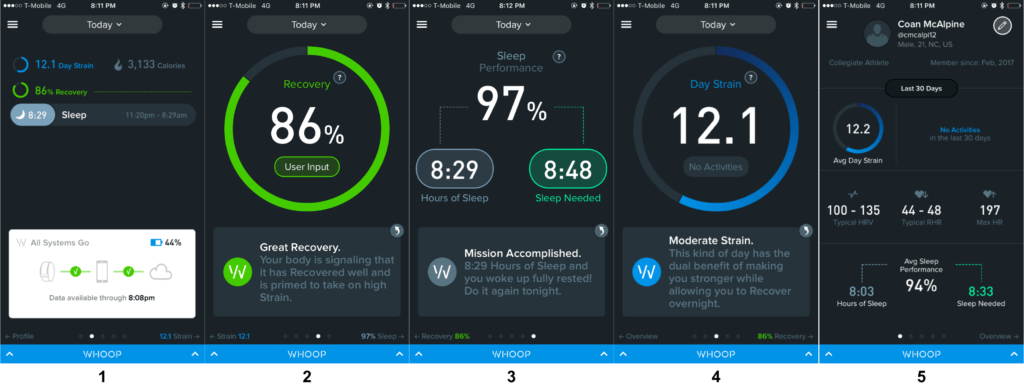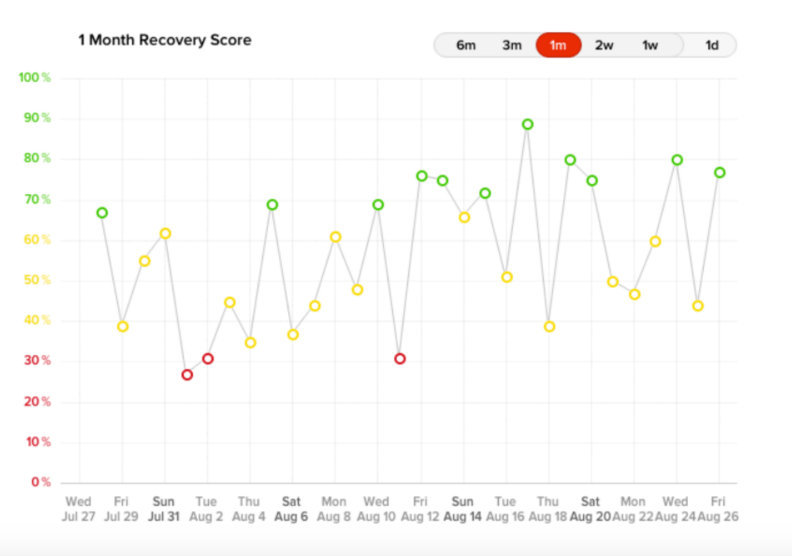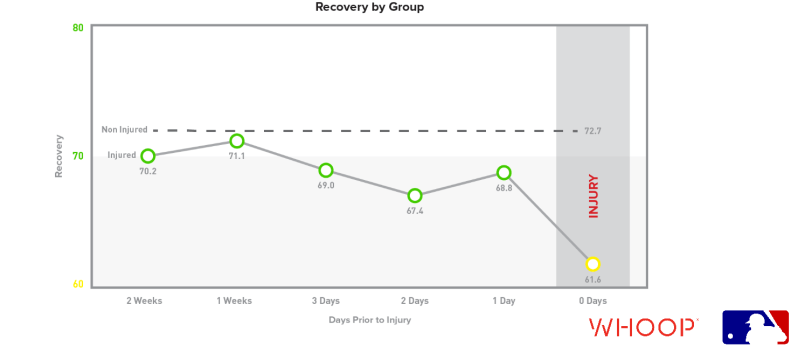WHOOP Strap 2.0 Review
(There is a newer version of this item. Check out our review of the Whoop Strap 3.0 here)

The WHOOP Strap 2.0 Review
Written by Ben Brewster
Being a metric-driven company, we are always looking for ways to improve our approach through measurement, whether the focus is strength, bar-speed, macronutrients, velocity, or in this case, recovery.
It’s no mystery that recovery is a huge differentiator between average and elite performers – the better you can recover, the higher workload you can sustain, the better adaptations you can expect, and the healthier you can stay over the long term. A big problem is the subjectivity of recovery – how we think we feel doesn’t necessarily indicate how ready our bodies actually are to take on stress. Furthermore, even when we do feel particularly good or bad, it’s often difficult without measurement to determine the root cause because nothing is tracked.
Perhaps the biggest issue of all is lack of self-awareness. Much like eating fruits and vegetables, recovery is something most of us know we should be focusing on, but put on the backburner, since, after all, it’s not like we’re being graded on our recovery each night.
Until now.
Enter the Whoop Strap 2.0 (recently partnered with the NFL and MLB), which claims pinpoint accuracy on a wide variety of recovery and performance metrics, all ultimately boiling down into one daily recovery score.
We were excited to put the WHOOP Strap through testing of our own, hopeful to be able to recommend a performance-monitoring device to take your recovery to the next level.
First Impression
The strap is simple, lightweight and unassuming. With an adjustable clasp attachment and a low profile, it won’t stand out or garner much attention while wearing it.
It feels light, but high quality, and with two green lasers coming out of the bottom directly into your wrist, you’ll feel like you’re wearing a James Bond spy gadget. For a strap that boasts it can be “comfortably worn 24 hours a day,” I had high expectations, and the strap did not disappoint (in fact, I haven’t taken it off for 8 weeks now) – just don’t expect to be making any fashion statements with this simple design.
Design and Durability
Perhaps one of the most important features of the band is that it is sweat, water, and training-proof. You can wear it anywhere, anytime…in bed, in the shower, at the gym, while throwing, etc…. and with a 2-day charge and a portable battery unit, the strap never has to come off. In fact, this was an intentional design by Whoop, as studies show that people are more likely to stop regularly wearing fitness trackers (like the Fitbit) if they have to take them off during their daily routine. This versatility is critical as you continuously collect data throughout your daily life. The only drawback here would have to be the battery pack’s size. Attachable directly to the top of the strap, this makes the strap a little gaudy to wear out and about while charging. I just pick a time to charge for a couple hours at home every 2 days and this is a non-issue.

Whoop Strap 2.0 with vs without the external battery pack
The strap connects to your phone via Bluetooth, and if at any point it gets disconnected, just double tap the strap to reconnect. This double-tap feature also illuminates the remaining battery life on the side of the strap. If your iPhone dies, don’t worry – the band stores all of its data for up to 3 days until you can get reconnected.
How does it work?
The primary purpose of the Whoop strap is to help athletes tell when they can expect to be at peak performance. As you may imagine, this type of training detail is a bit excessive for the casual athlete, so Whoop has geared its platform primarily at college and professional athletes looking to gain every last insight into their performance.
As far as what the strap measures, it constantly monitors your heart rate, even while you sleep, and detects activity automatically using a built-in accelerometer(for example, it knows when you workout, fall asleep, wake up, and even what sleep phase you’re in at any point during the night. It even picks up sleep metrics like number of “disturbances” and compares it to your recent averages). Of course, you can manually enter exact activity details to get more accurate outputs (such as calorie expenditure), but I’ve found that the automatic setting seems to be quite accurate without having to enter any additional inputs.
Heart Rate Variability
The constant heart rate monitoring allows Whoop to calculate Heart Rate Variability (HRV), which is a metric that indicates the irregularity of heart beats throughout the day, and is used in studying performance and adaptation to stress. Put simply, a higher HRV is associated with good health, increased performance and recovery, a lower resting heart rate and better cardiovascular fitness. A lower HRV is associated with stress, fatigue and burnout.
Because HRV can vary greatly person to person (and fluctuates based on a ton of factors like sickness, psychological stress, fatigue, hydration, alcohol, stimulants and sleep quality), Whoop’s biggest strength is being able to first generate a baseline, learn your specific patterns and then compare your daily data to this baseline to more accurately assess if you’re recovering properly and moving in the right direction. In fact, it takes 3-4 days of wearing the strap before you actually start to get an accurate idea of HRV as the strap creates this individual baseline. The longer you continue to wear the band, the more accurate the readings become relative to you.
“Whoop’s biggest strength is being able to generate a baseline, learn your specific patterns and then compare your daily data to this baseline”
Combined with detailed sleep tracking, HRV is sent through Whoop’s Algorithm to give you a Recovery Score as a percentage out of 100. To increase the accuracy of this score, Whoop takes you through a series of optional questions each day based on how you subjectively feel in the morning as well as your nighttime sleep habits (screen time, alcohol, sexual activities, etc.).
Inside the Mobile App:
There are quite a few features in the WHOOP mobile app, so for the sake of this review we’ll just cover the essentials. Here are some screenshots from the app, and what they mean (my training partner also has a WHOOP – these were his scores from the other day).
- General overview screen. Here the app summarizes your daily Strain score, up-to-the-minute calories burned, gives you your Recovery score from the previous night, total hours slept and more. Once you get comfortable with the app, this is the main screen you’ll be glancing at each morning to get a feel for what to expect that day.
- Recovery score. Here you can input further data by answering some questions on how you subjectively feel (tired, rested, sore, exhausted, etc), which will help improve the accuracy of future scores even more as the app learns your patterns.
- Sleep performance. This gives you an overview and a score on your sleep from the previous night, and if it met your needs (the app adjusts sleep needed based on your recovery needs after the previous night and depending upon your Strain score). Much more in depth sleep info is available as well, including a full breakdown on your sleep cycles (Light/REM/Deep sleep) and minute-by-minute heart rate and heart rate variability throughout the night. Honestly, this is more than most of you reading this will ever need, but it’s pretty neat to have nonetheless.
- Day Strain score. A score from 0 to 21.0 that approximates how strenuous your overall day was. 0-9.9 = light, 10.0-13.9 = moderate, 14.0-17.9 = strenuous, 18.0-21.0 = all-out. Thus, if your workload suddenly spikes (for example, going on a 5 mile hike on top of your regular training), the app will adjust for that in your continuously updated Strain score for the day and make adjustments to your sleep recommendations.
- 30-day overview. See how you’ve been doing over the past month in these metrics.
*Note: This product is currently only compatible with iPhones; Android compatibility to be added later.

Does it actually change habits?
My activity and sleep patterns became quite clear over the past 8 weeks of using the device – higher intensity training sessions resulted in higher Strain scores, and longer recommended sleep duration. When my sleep performance suffered, I was predictably sluggish compared to days when I woke up with perfect scores. You can’t trick the band either – NyQuil for better sleep? Forget about it. Your REM and Deep sleep metrics suffer, and you’ll end up with a mediocre recovery score. The same goes for having a couple alcoholic drinks before bed, validating what many of us have heard for years about alcohol and sleep aids being inferior to deep, natural sleep for performance.

As you begin to change your habits, your recovery trends should begin to improve (green = good recovery).
In fact, since using the band and seeing the resulting effects on my recovery the following days, I now:
- Feel noticeably better. You’ll still have up and down days where you’re dragging, but simply by being more aware of this aspect of performance you’ll start to make smarter choices and minimize activities that clearly correlate to poor scores (late nights, drinking and particularly high psychological stressors). In fact, I haven’t had one “poor” recovery day in the past month, although I’m sure I just jinxed myself.
- Completely avoid artificial sleep aids such as NyQuil, which I can only see as being beneficial for recovery in cases of insomnia where the alternative to 8 hours of low quality sleep is only several hours of natural sleep.
- Limit alcohol consumption to 1 drink or less, no more than one day a week (the effects of this are negligent, but several drinks or more will noticeably screw up your recovery scores, even if you think you’re sleeping better).
- Get to bed before midnight, after seeing the results of 8 hours of poorly timed sleep (>12am) vs 8 hours of well timed sleep on my recovery. I estimate that, on average, I now go to bed about an hour earlier than before I started.
- Intelligently experiment with natural sleep aids, like ZMA and lavender oil since I have an objective way to measure if they and other supplements are having a noticeable impact or not.
- Practice better “sleep hygiene” including keeping room temperature cool, avoiding excessive screen time before bed (especially blue light), and installing black-out curtains. Make your room a cave – you’ll hibernate like a bear and your scores should improve.
Does better recovery equal better performance?
The short answer is: it depends. Better recovery will set yourself up to have higher physical and cognitive performance, but this doesn’t mean you’re guaranteed to hit PRs on 90% recovery days and destined to fall flat on your face on poor days. Far from it. The scores, while accurate, are just a starting point – back off when all signs are pointing to your body needing a break, but don’t let one bad recovery score become a self-fulfilling prophecy for that day’s training. Some days you won’t sleep as well as you’d like, or other uncontrollable stressors will arise. This doesn’t mean you can’t still push through at times and have productive training.
“Back off when all signs are pointing to your body needing a break, but don’t let one bad recovery score become a self-fulfilling prophecy for that day’s training.”
The MLB Study and Whoop
Last year, Whoop issued 280 straps to minor leaguers across 28 MLB organizations, and collected data on how the recovery metrics related to velocity, bat speed, travel, injuries and more. A study of this size allowed them to draw some interesting conclusions (none of which are particularly surprising to me after my experiences). For a full summary of this study, go here. Both fastball velocity for pitchers and ball exit velocity for hitters, relative to each player’s individual averages, showed positive trends based on recovery, as you’d expect over a large sample size.
Adjusted individual fastball and exit velocities. Players tended to perform better on days they were better recovered (Whoop admits more data is needed).
Can Whoop Predict Injury?
Another interesting finding of the study was recovery and injury risk. Of the 12 reported non-contact injuries during the study, there was (on average) both a decrease in recovery in the weeks leading up to the injury, and, probably more relevantly, on the day of the injury itself. This is also unsurprising, as we know that the effects of physiological and psychological stressors are cumulative. If you allow recovery to spiral downhill (for example, due to overtraining or chronically high stress levels), it makes sense that the susceptibility to injury would rise.

Injured vs. Non-injured players had differences in average recovery scores, both leading up to and on the day of the injuries.
I spoke with two other pro pitchers about their experiences with the strap, and how they felt it affected their training. Xavier Borde, who was issued a Whoop Strap with the Orioles in 2016 and used it for the entire 2016/2017 offseason commented,
“I can’t ever fool it…I was working 4am shifts, and when I worked, my recovery suffered. Now that I’m not working (and sleeping more), my recovery is perfect according to the band every day. Now, did the low readings stop me from hitting personal records? No. But it definitely distinguished my harder days from my easy days.
Joe Beimel, 13 year MLB veteran (and still playing professionally at age 40) turned me on to the Whoop Strap originally. In his words,
“It takes the guessing out of how hard you should push yourself day in and day out. It also makes the individual accountable for their recovery score by making sure you get enough sleep and take care of yourself through out the day. The only thing I don’t like about it is how the original strap that comes with it gets a little fuzzy over time.”
Joe Beimel, 40 (a.k.a. “the man”), uses Whoop to optimize his recovery and training.
Final Thoughts
With a list price of $500.00 (discount code at the end of this article) for the strap, the WHOOP Strap definitely isn’t for everyone (UPDATE: Whoop has tried to improve the accessibility of their product to everyone is now offering the product at $174.00 with the strap included. This includes 6-months of portal access and the physical strap. Every month of access after this period is $29.00/month.) Again, it can’t really be compared to other “budget” fitness trackers, because it’s features are so much more extensive, and the focus here is on recovery, not just calorie or step counting. This device is for the serious athlete who is trying to squeeze every last ounce of performance out of his body and willing to invest in every tool that may help get them there. Is it necessary? No, but neither is having a radar gun for throwing hard or a bar-speed device for power training – it just helps keep things objective when it comes to your recovery, which will lead to better progress in that arena. How much is that objectivity worth to you? That’s on you to decide.
“This device is for the serious athlete who is trying to squeeze every last ounce of performance out of his body.”
For most of you, sticking to a familiar sleep and training schedule, monitoring how you feel along with your hydration and calorie intake should suffice. Do all the little things, be honest with yourself about your recovery and your daily limitations, be able to dial up or down when needed, and you should be just fine.
After reading this Whoop Strap 2.0 review, for those of you who are interested, you can check out the Whoop Strap 2.0 at their website.
** Enjoy the first month on us ($30.00 value) by purchasing through this link**
(Review of the Whoop Strap 3.0 can be found here)
